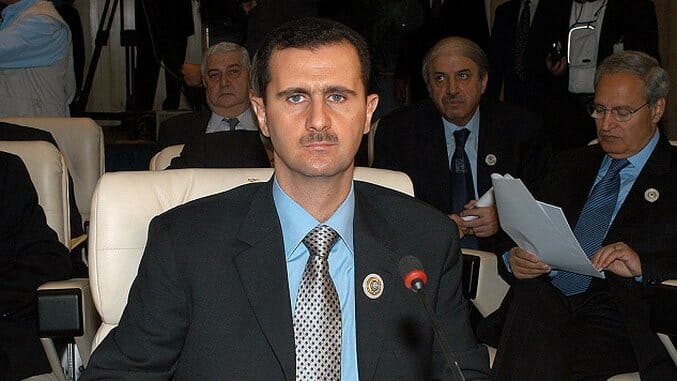On April 7, social media users, non-governmental organizations, and other open-source outlets reported a chemical weapons bombardment in Douma. Videos and images show the remnants of at least two chlorine barrel bombs from the attacks with features consistent with chlorine barrel bombs from past attacks. In addition, a large volume of high-resolution, reliable photos and video from Douma clearly documents victims suffering from asphyxiation and foaming at the mouth, with no visible signs of external wounds. The World Health Organization (WHO) issued a statement about its concern over suspected chemical attacks in Syria, noting that victims showed symptoms consistent with exposure to toxic chemicals.
That might sound like an insane question, but it’s not, especially the “why” part. Even if you think it’s obvious the Russians are lying, as I do, the answers offer important lessons in belief, evidence, and the extra-judicial use of military force.
First, let’s take a close and fair look at the competing claims.
The first strike against what the White House said happened: The White House said it happened. They lie all the time, and at this point have negative credibility. Beyond that, though, there are a few other legitimate reasons to check your belief.
First, consider the type of evidence: Reports, pictures, and video. Though pictures and video can be convincing, and in this case they certainly are, the White House statement offers no incontrovertible hard proof that chemical weapons were used, or who used them. On this pretense we launched an attack on a sovereign state, an attack incompatible with both international and constitutional law.
As for the justification of that pretense, the statement goes into more detail, and cites as further evidence the reported use of helicopters to drop the barrel bombs containing the alleged chemicals. This makes absolute sense: Something dropped the barrel bombs from the sky, and the White House notes that “no non-state group has conducted air operations in the [Syrian Civil War].” The statement also cites local reports of a specific helicopter, an Mi-8, which we know the Syrian military houses at an airbase close to Douma.
But let’s advocate for the devil: If we take the position that the White House is lying, how might we support that assumption?
We could point to the White House’s credibility, as mentioned above. We could also go further and argue that it’s not just this White House: The U.S. is a deceptive and often ignoble colonial power, and our government can’t be taken at face value. To back that claim up we might point to our history of carrying out “false flag” operations, perhaps most relevantly the Gulf of Tonkin incident that the U.S. used as pretext to get involved in the Vietnam War. The U.S. later admitted this attack was faked. (“False flag” operations are attacks or other events carried out by one group to deceive another group into blaming someone else, all in order to create a pretext for launching a war or something like that.) The logic behind the false flag: We want a reason to take the war to Assad. Not only that, but the last time we craved war in the Middle East, the same chemical weapons justification was used—I’m speaking, of course, of the invasion of Iraq that led to the death of Saddam Hussein.
Additionally, there’s good reason to be at least a little skeptical of the type of evidence the White House cited. Photos and video can be faked, and the scene could be staged. Also, the first-hand reports we have of the attack, along with the reports of helicopters, come from unnamed sources. Who are those people? Why should we believe them? What competing interests might they have that would induce them to lie or make the truth messy? And what’s the “reliable intelligence” the White House cites that proves the Syrian government coordinated the attack? Why is that information “reliable”?
These questions poke at weak joints in the White House’s story: There’s no proof in them that rules out the possibility the attack wasn’t staged, or carried out by the rebels. Which brings us to Russia.
Why Should We Believe the Kremlin?
First, the Kremlin hasn’t yet offered the “irrefutable evidence” it claims proves the April 7 chemical attacks were staged. Also, it’s the Kremlin, which these days has about as much credibility as the White House.
But there’s a twist: Back in March, one month before the attack, Russian Armed Forces Chief of General Staff Valery Gerasimov predicted the U.S. and/or our allies might carry out a false flag chemical weapons attack, blame it on the Syrian government and Russia, and use it as a pretext to attack Syria.
Yeah: In March.
Gerasimov went on to specify the Russian military had “reliable information” that “terrorists” planned to launch the false attack in Eastern Ghouta, the region where the alleged attack did indeed take place. He also claimed that “White Helmets” activists and film crews were already in place, and that they had satellite communications equipment to broadcast the fake attack. We haven’t seen proof of this, of course, but the fact that Gerasimov seems to have predicted this very event, and in some detail, is pretty compelling.
After the attack, Russian Foreign Minister Sergei Lavrov pushed the same story: The attack was staged. The Russian military went a step further and blamed the U.K. specifically. Other Russian government officials have told the same story.
Russia has yet to provide evidence to support these claims.
But Russia has added that its inspectors on the ground in Douma haven’t found any evidence of a chemical attack. General Gerasimov said “independent” Russian inspectors “took soil samples, collected fragments from the so-called place of the alleged chemical weapons attack” and concluded those samples “showed the absence of nerve agents and chlorine-containing poisonous substances.”
As of the time of this writing, it’s unclear how you can prove the absence of something.
The general added that after a “visit to the medical facility shown on the set of the White Helmets, the interview of the medical staff and the patients, neither facts of the use of poisonous substances nor injured among the inhabitants of this city were detected.”
But Russia controls the attack sites, and outside inspectors have so far been blocked from gaining access. According to the BBC, one U.N. security team “came under small arms fire, and an explosive was detonated.”
Still, the Russian government has been consistent in its claim: The attack was faked.
But was it?
Conclusions
First, let’s note that the official White House statement also made specific claims of fact. The most relevant of these:
The World Health Organization (WHO) issued a statement about its concern over suspected chemical attacks in Syria, noting that victims showed symptoms consistent with exposure to toxic chemicals…. The symptoms described in reporting from media, non-governmental organizations (NGOs), and other open sources—such as the WHO—include miosis (constricted pupils), convulsions, and disruption to central nervous systems. These symptoms, in addition to the dozens of deaths and hundreds of injuries reported, suggest that the regime also used sarin in its attacks on April 7.
The World Health Organization also said it had treated 500 patients in Douma that exhibited these and similar symptoms.
This means we have competing evidentiary claims: The WHO—an independent international organization with zero interest in escalating a large-scale war—versus the Kremlin. Who to believe?
Here let’s note that reporters from CBS news and CNN have since made it into Douma and spoken with residents there. Watch this video and tell me these are actors.
The CBS correspondent, who gained access to the alleged attack site, reported a resident describing the attack: “All of a sudden some gas spread around us. We couldn’t breathe. It smelled like chlorine.” Another resident showed CBS a yellow gas canister, similar to others used in earlier chlorine attacks. He said the canister had been dropped through the roof of the building.
In addition, a journalist from the U.K. publication The Independent reported from the ground in Douma that he’d met a Syrian doctor, Dr. Assim Rahaibani, who “cheerfully tells me that the ‘gas’ videotape which horrified the world-despite all the doubters-is perfectly genuine.” So yeah, shocker: It’s not a fake video, folks.
But Dr. Rahaibani adds a twist to his report: The victims weren’t killed by gas; they died of oxygen starvation, suffocating in the tunnels and basements where they lived. He said a combination of heavy wind and heavy bombing whipped up a deadly dust storm. The doctor, though, wasn’t an eyewitness, and the reporter is careful to observe the doctor also repeatedly called a certain group of fighters “terrorists”—which he notes is the Assad government’s term for their enemies. And to this the reporter from The Independent adds that “many people [he] talked to amid the ruins of the town said they had ‘never believed in’ gas stories—which were usually put about, they claimed, by the armed Islamist groups.”
This story, though, directly contradicts Russia’s claim that the attack was faked: All these people say an attack happened, but some have questioned the chemical element.
So yeah, I guess it’s possible the rebels carried out the attack, but if they did they’d need to have upgraded their military capability exponentially. And given the sickening video evidence and testimony on the ground, it’s impossible to believe the attacks didn’t happen at all, and very tough to believe it wasn’t chemical.
But maybe the U.S. or the U.K. actually got people to launch the attack on their behalf. If you believe we or the U.K. ordered someone to gas kids, I hope you don’t have a driver’s license and never vote.
And if you’re still not convinced, the U.S. now has made chemical analyses of blood and urine from victims, and they tested positive for exposure to nerve agent and chlorine.
Conclusion: This is beyond all reasonable doubt a chemical attack carried out at the direction of the Syrian government.
Why This Is Important
Here’s a logical counterpoint, though: If Assad did gas his own people, and he’s done this several times, it’s an invitation to the U.S. to turn its military against him. This is stupid, and a compelling reason to suspect he didn’t do it.
But maybe it’s not so stupid.
Assad could have a reason for this senseless attack. It’s twofold: He’s testing the resolve of the U.S., and he’s also showing the international community what he can get away with. Effectively, Assad is claiming victory and asserting complete domain of his country.
So yes, it might seem stupid to bait the wrath of the U.S. and international community, but the gamble seems to have paid off. Look at the price Assad paid for the attacks: Nothing. A couple of pinprick missile strikes on some army fortifications with plenty of heads-up from the United States.
Still, Assad took a hell of a risk here, especially considering President Trump is more likely than Obama was to enforce a “red line.” And the dictator himself should be concerned about meeting the same fate that befell Saddam Hussein and Muammar Gaddafi, two dictators the U.S. took down in the region. He probably isn’t, though, because he’s got something those other two guys didn’t have: allies. Assad has the support of Russia and Iran, who both have a military presence and stake in the country. Iraq and Libya didn’t have the support of anyone nearly as strong as those two countries.
In the end, I think Assad has called Trump’s bluff. Trump has no idea what to do here. I mean, he’s turned to Macron for advice.
But back to the problem with the evidence. The problem here is the room for doubt. The only hard evidence the U.S. cited ahead of our missile strike was easy to discredit; not on its merits, of course, but on the form of the evidence, such as social media, pictures, and third-party reports. It was only after the attack that we produced our chemical analysis.
The big lesson here is that we need to demand hard evidence before launching a missile strike on a sovereign nation. I mean, even Dylann Roof got a trial. The process is more important than we might understand, and we can’t let our institutions crack. This extra-judicial missile launch, small as it was, sets us on a dangerous path: Unilateral action, sanctioned only by the opinions of the attackers. A knee-jerk response wasn’t necessary here, and indeed it didn’t take long for incontrovertible hard evidence to surface. Trump should have, as Trump’s Secretary of Defense General James Mattis advised, at the very least gone to Congress, and we should have shown enough restraint to wait until we could present our hard evidence to the international committee. If at that point they still balk, unilateral military action becomes a more viable option. (The Iraq invasion is a glaring counterpoint.)
But Assad, we must admit, might have us beat. Trump’s ego and inexperience pose a threat of escalation and full-on war, which will destroy Assad’s regime, but that’s not a likely option. The U.S. won’t approve of ground troops and occupation of rebel areas, which risks an almost inevitable conflict that might lead to war with Russia. No one in the world wants that to happen, including Trump, who won’t attack Russian interests without making sure Putin has a nice fat heads-up. Trump’s infamous tweet about the missiles coming, which so many interpreted as his first threat to Putin, was pure grandstanding. Putin didn’t see any missiles. We warned him. It was a bluff, and we all bought it.
So I believe we’re going to back down in Syria, and in the end that might be for the best, in the sense that it doesn’t risk full-blown war between nuclear powers.
But there’s really no “for the best” in Syria. Trump is correct in one respect: Assad is a “Gas Killing Animal.” If you haven’t already, please watch this video from the attack sites.
Syria is the biggest humanitarian tragedy of our time, and the biggest stain on American foreign policy in who knows how long. Well, since 2003 I guess. But the human toll in the Syrian Civil War is beyond reckoning. It’s so bad that the U.N. has stopped counting the number of people killed. The most recent estimate, from 2016, reckons that more than 400,000 people have died in the war. It’s sick. And though there might not be a palatable military solution, there is a human one: If Donald Trump really does care about all those “beautiful babies” that the Gas Killing Animal is slaughtering, not only with chlorine but with guns and fires and thousands of barrel bombs, he could start letting them into the country he leads. But we’re not, and that’s damning evidence in its own right.
















































































